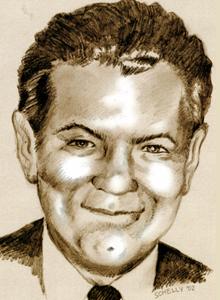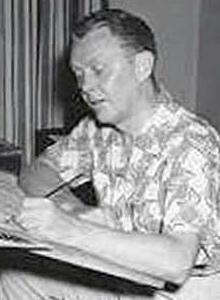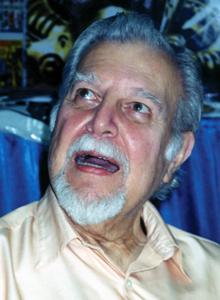Since the founding of the Will Eisner Comic Industry Awards (and their previous incarnation, the Kirby Awards), the following individuals have been inducted into the Hall of Fame.

Otto Binder
1911–1974
In comics, Otto Binder is best known as the chief writer for various Captain Marvel titles, helping create the mythology of The Big Red Cheese. Between 1943 and 1951 he wrote nearly 800 stories for Captain Marvel, Marvel Family, Captain Marvel Jr., and related titles. In addition, he wrote some 2,000 other stories in nearly 200 different titles during comics’ Golden Age.
Inducted 2004

Charles Biro
1911–1972
Charles Biro is credited with creating the crime comics genre back in 1942 with the seminal title Crime Does Not Pay, for which he drew 57 covers as well as writing dozens of stories. A consummate storyteller, Biro also wrote and created “Crimebuster” for Boy Comics and “The Little Wise Guys” for Lev Gleason’s Daredevil series.
Inducted 2002

Bill Blackbeard
1926–2011
Writer/editor/archivist Bill Blackbeard co-edited The Smithsonian Collection of Newspaper Comics, published in 1977. In the 1960s Blackbeard formed the San Francisco Academy of Comic Art. His collection (now housed at Ohio State University’s Cartoon Research Library) consists of clipped comic strips, whole comics pages, and complete Sunday sections. These archives have been used for award-winning collections of Popeye, Krazy Kat, The Katzenjammer Kids, Yellow Kid, and other classic newspaper strip reprints.
Inducted 2011

Vaughn Bodé
1947–1975
In a career that barely spanned two decades, Vaughn Bodé produced a phenomenal body of work. Among his publications are the self-published Das Kampf, which was one of the first underground comics in 1963. He was the editor of Gothic Blimp Works, the first weekly underground comic published in the 1960s. His “Cheech Wizard” appeared in National Lampoon from 1971 to 1975.
Inducted 2006

Brian Bolland
1951–
Brian Bolland is a British comic book artist originally known for his work on Judge Dredd. He was one of the first British artists to be recruited by DC Comics in the early days of what became known as “the British Invasion,” which revolutionized the industry in the 1980s. One of his earliest works for DC was Justice League of America #200 in 1982, though he is better remembered for the 12-issue limited series Camelot 3000, DC’s first ever “maxi-series.” He also drew the Batman graphic novel The Killing Joke, written by Alan Moore, and a Judge Dredd/Batman team-up, also by Moore. In recent years, he has concentrated mainly on providing cover art, most of it for DC.
Inducted 2023

Wayne Boring
1905–1987
Wayne Boring was one of the best-known and most influential Superman artists. He started out as an art assistant in the Siegel & Shuster studio in 1937. After Superman became a hit, Boring became the artist for the syndicated newspaper strip and was hired by DC in 1942 to draw Superman comics, which he did for nearly 20 years, aided by inker Stan Kaye. Many credit Boring with establishing the iconic look of Superman during the character’s most popular period.
Inducted 2007

Alberto Breccia
1919–1993
Breccia was an Argentinean artist who worked from the 1940s through the 1980s. Starting out in commercial illustration for magazines, juvenile tales, and genre stories, His first major character, a detective named Sherlock Time, appeared in the late 1950s and was written by Héctor German Oesterheld, who would become a long-time collaborator. Their “masterpiece” is considered Mort Cinder, produced from 1962 to 1964. Breccia worked with and was influenced by Hugo Pratt and was made a member of the “Venice Group” that Pratt and other European artists created. One of Breccia’s last works was a series called Perramus, a critique of life under dictatorship, that was begun when Argentina was still under the control of the dictatorship that was very likely responsible for the disappearance of Oesterheld. This act of artistic courage led to an award from Amnesty International in 1989.
Inducted 2021

Nell Brinkley
1886–1944
Nell Brinkley was an American illustrator and comics artist who was sometimes referred to as the “Queen of Comics” during her nearly four-decade career working with New York newspapers and magazines. Her comics are a luxuriously rendered visual chronicle of woman’s progress over the decades, from her Victorian-era heroines to her Deco-styled independent working women. Her iconic Brinkley Girl, celebrated in song and on stage, surpassed the Gibson Girl in popularity. Her creative legacy can be seen in the work of artists from Dale Messick, Ramona Fradon, and Marie Severin to Trina Robbins, as well as in shoujo manga.
Inducted 2020

John Broome
1886–1944
John Broome is best known as a writer for DC, where he worked from 1946 to 1970 on such titles as the Silver Age Green Lantern and Flash series as well as several Justice Society of America stories. He created many DC characters and institutions, including the 1940s Atomic Knights, the Silver Age Flash Rogues Gallery of supervillains, the (Green Lantern) Guardians of the Universe, and the Elongated Man.
Inducted 2008

Marjorie (“Marge”) Henderson Buell
1904–1993
In 1935 Marge’s single-panel gag cartoon “Little Lulu” first appeared in The Saturday Evening Post. Marge continued producing this hugely popular cartoon featuring the mischievous kid through 1944, when it went on to become a weekly comic strip. Buell stopped drawing Little Lulu in 1947, but although the work was done by others, she kept creative control. Little Lulu became a successful series of animated cartoons and a popular comic book for Dell/Gold Key (done by other cartoonists, most notably John Stanley). Lulu (drawn by Marge) was the mascot for Kleenex tissues from 1952 to 1965.
Inducted 2015

Carl Burgos
1916–1984
Carl Burgos joined the Harry Chesler shop in 1938. He spent most of 1938 and 1939 writing and drawing features like “Iron Skull” and “Stoney Dawson” for the Centaur group. Burgos moved to Lloyd Jacquet’s Funnies, Inc. studio, and together with Bill Everett began working at Timely’s Marvel Comics. While Everett created the Sub-Mariner strip, Burgos created the flaming android known as the Human Torch. The fiery character caught on and was appearing in his own book by autumn 1940. Burgos left the strip and comics in 1942 and, besides an occasional reappearance in color comics, spent most of the next 25 years in advertising art.
Inducted 2016

John Buscema
1927–2002
Fan favorite artist John Buscema is probably best known for his work at Marvel, drawing The Silver Surfer and Conan the Barbarian, plus pretty much every other character the company produced from the 1960s through the 1990s. He influenced many an aspiring penciller with his art in Stan Lee’s How to Draw Comics the Marvel Way.
Inducted 2002

Ernie Bushmiller
1905–1982
Ernie Bushmiller got his start as a cartoonist when he took over the Fritzi Ritz comic strip in 1925. In 1933, he added Fritzi’s niece Nancy to the strip. The character became so popular that Ernie changed the name of the strip to Nancy in 1938. Ernie continued to do the newspaper strip (with the help of various assistants) until his death at the age of 77.
Inducted 2011

John Byrne
1950–
Writer/artist John Byrne is best known for his long run on Uncanny
X-Men (beginning with writer Chris Claremont in 1977), including the classic “Days of Future Past” and “Dark Phoenix” story arcs. During that time he created Alpha Flight, Proteus, and Kitty Pryde. This work was followed by a five-year run (1981–1986) on Fantastic Four along with the Alpha Flight series. In 1986 he revamped Superman for DC and worked on various Superman titles for two years, after which he returned to Marvel to write and draw such titles as The Sensational She-Hulk, Namor the Sub-Mariner, and West Coast Avengers. In the 1990s he produced the creator-owned series Next Men for Dark Horse. He continues to produce work for IDW and other publishers.
Inducted 2015

E. Simms Campbell
1906–1971
E. Simms Campbell was an indispensable part of Esquire magazine’s birth in the early 1930s. He established its visual style and invented the original “Esky” mascot character. And, in the words of its founding editor Arnold Gingrich, his full-page color cartoons “catapulted the magazine’s circulation from the start.” Campbell may also be the first African American illustrator not only to break the color line in mass-market publications but to earn widespread public acclaim as well. During his art career, Campbell produced cartoons for a variety of magazines such as Life, Cosmopolitan, and nearly every issue of Esquire until his early-1960s hop over to Playboy. He did covers for Judge and The New Yorker and created woodcut-style illustrations for a Langston Hughes young adult novel.
Inducted 2020